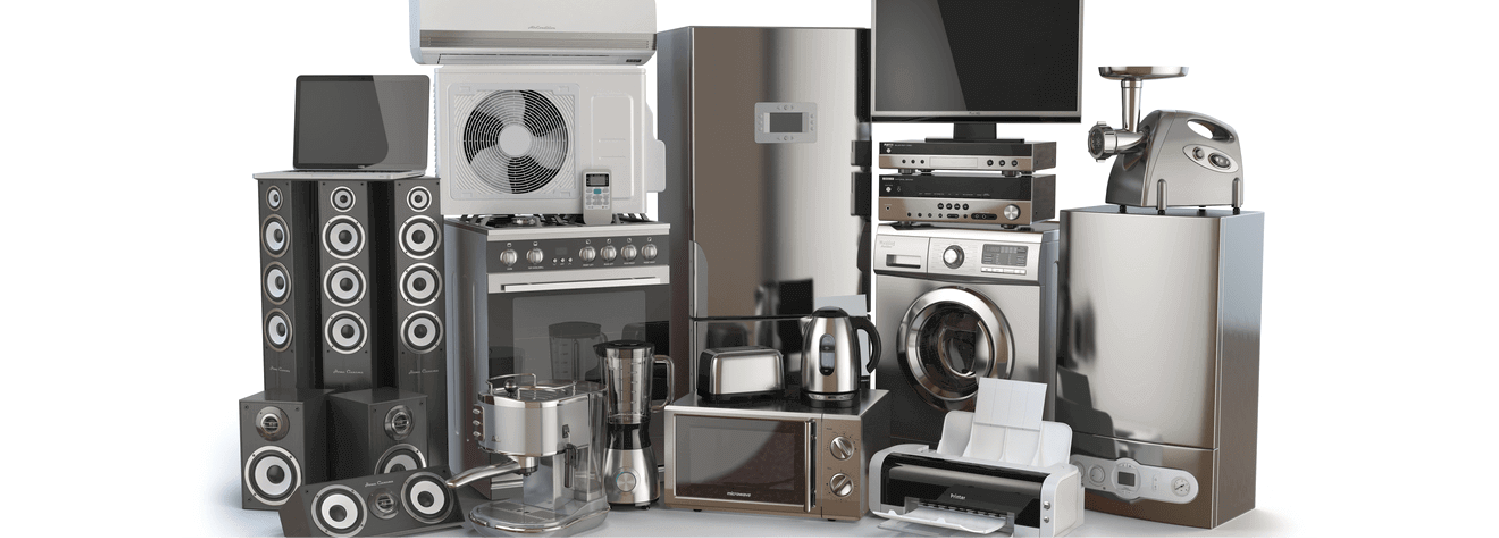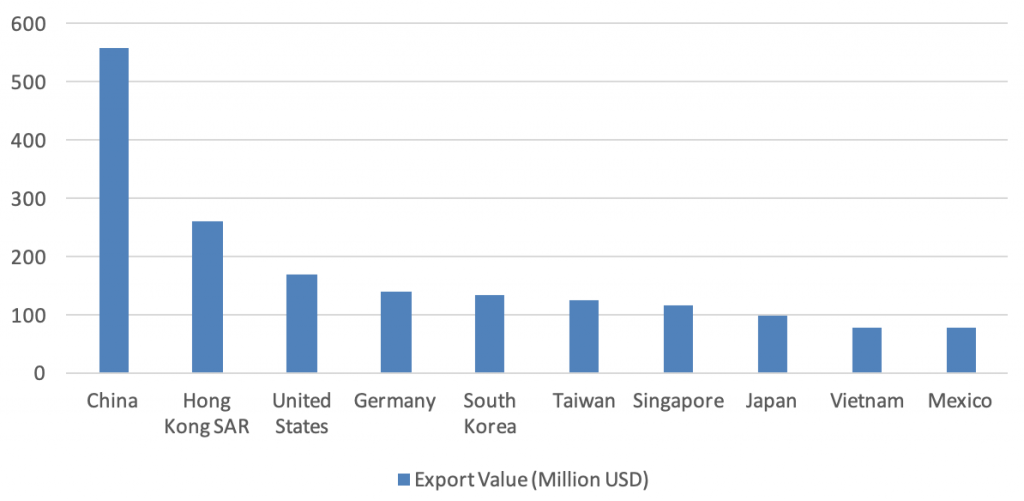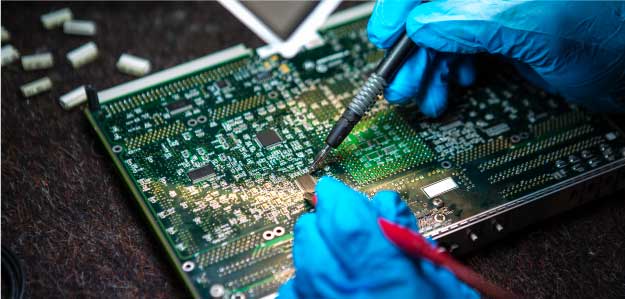Global consumer electronics is an industry that is constantly evolving through trends, market changes, and advanced technology. Products under this industry easily become obsolete due to rapid product development and production. If you happened to be one of those electronic manufacturers, this industry report should come in handy for you as part of your market research.
Consumer Electronics Industry Overview & Key Statistics
a. Consumer electronics industry description
The term consumer electronics pertains to a broad range of electronic equipment with functionalities designed for casual daily use of end users. It comprises two product segments – brown goods (communications or entertainment gadgets like TVs, DVD players, smartphones, tablets, and printers) and white goods (housekeeping devices like refrigerators, washing machines, and built-in kitchen systems).
The latter is different from the so-called white label manufacturing in consumer electronics production. White goods pertain to a product category while white label is a way of producing goods, which involves the manufacture and supply of generic products (flash drives, power banks, phones, monitors and displays) to offshore retailers which resell them under their own labels. While a specific product prototype may be manufactured by specialized suppliers, white label goods are typically similar for a given product category.
China is the world’s largest consumer electronics producer, especially for brown goods product category. It is the world’s most extensive electronics manufacturing ecosystem and supply chain, with more than five times the electronics suppliers based in Japan and a labor force of manufacturing workers close to 150 million.
The industry quickly recovered in 2017 with a market growth of 3.4%, thanks to renewed consumer interest in smart wearables, next-generation LCD TVs, and smartphones despite a brief dip in production output by 1.5% in 2016, according to research firm Reed. However, the recent COVID-19 outbreak has greatly affected not only China but the entire world’s electronics production. This notwithstanding, consumer electronics still topped China’s list of export products in 2020, accounting for 42% of the total electronic exports to the US alone.
b. Global consumer electronics production: China vs. other regions of the world
According to IBISWorld, the global consumer electronics manufacturing industry was valued at $414.32 billion in 2020. BizVibe estimated that China’s production corresponds to more than one-third of the global consumer electronics manufacturing output. Research from World’s Top Exports found that for the year 2020, China’s worldwide production share of electronic circuit components is at 32.9% ahead of other electronics manufacturing hubs such as Taiwan (14%), South Korea (11%), and Singapore (10.7%). China is likewise the world’s largest consumer electronics exporter, with estimated earnings of US$557 billion and accounting for 24% of the US$2 trillion worth of exports worldwide back in 2017. The actual value is likely significantly higher than these estimates, considering that exports through Hong Kong usually originate from Mainland China as well. However, the number largely dropped in 2020 due to the pandemic but is expected to slowly rise again as the world recovers from this crisis.
Top 10 Consumer Electronics Exporters in 2016
(Source: International Trade Center)
China’s production still owns largest world market share for its electronics exports in 2020 with a wide spectrum of consumer electronics; electrical machinery/equipment US$710.1 billion dollars, computers US$440.3 billion dollars, and lighting and other electronic products at US$110 billion dollars.
c. Commonly produced consumer electronics in China
- Smartphones
- Tablets
- Laptops
- Computers
- LED TVs
- Wearable electronics
- Drones
- Power banks
d. Year-on-year consumer electronics industry growth
According to China Information Technology Industry, China’s electronics production volume’s growth rate grew from 10% in 2016 to 14.5% in April 2017, the highest in over five years. The industry boosts China’s industrial upgrade with its value-added output expanding 13.9% year on year.
The industry’s rapid development is attributed to the sophistication of China’s Information and Communication Technology (ICT) sector and greater consumer demand for virtual reality, smart gadgets, and drones. Smartphone production alone grew from 237.2 million units in 2012 to 901.2 million units in 2017. As expected, the numbers greatly dropped in 2020 as China now only holds 68% of worldwide smartphone production from 74% in 2017 which allowed other countries to keep up with China’s smartphone production.
Smartphone Production in China
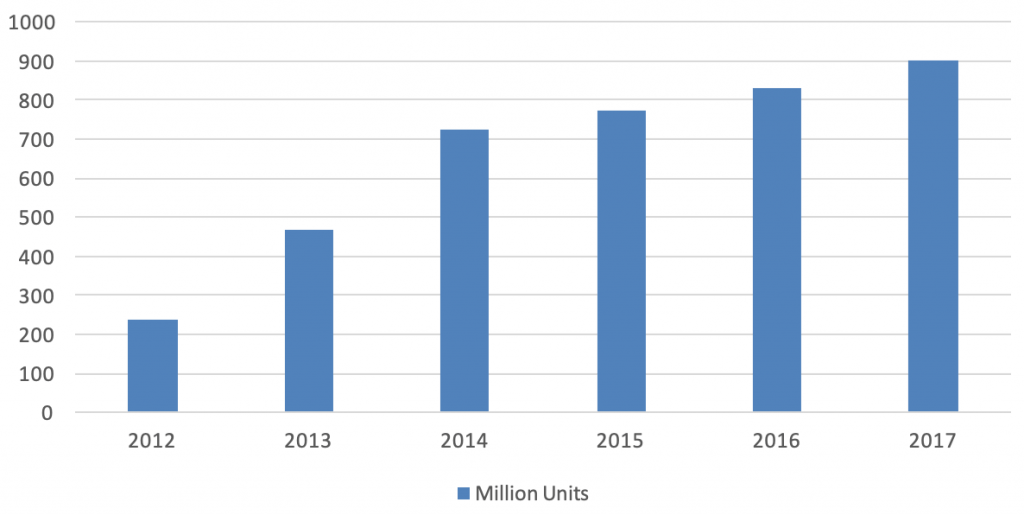
Why China is the Right Choice for Consumer Electronics Production
a. Consumer electronics production capacity
In terms of large-scale production of consumer electronics, China remains the go-to destination. Shenzhen alone, the so-called the “electronics capital of the world” or “the Silicon Valley of hardware” home to more than 4,700 national-level high-tech enterprises, 30,000 science and technology companies, 5,000 product integrators and design houses, caters to the white label requirements of majority of the world’s premium consumer electronics brands – Apple, Sony, Nintendo, Dell, Acer, Microsoft, and Huawei – all of which work with Chinese suppliers usually unheard of in the West, with the exception of Foxconn.
China‘s consumer electronics production has a comparative advantage over other consumer electronics manufacturing countries. Strong supplier and supply chain infrastructure tops the list of China’s industry strengths, enabling it to fulfill large volume orders at shorter production lead times.
A smartphone, for instance, requires 2,000 different components – from tiny machine screws and capacitors to circuit boards and LCD screens – all of which are readily sourced from China’s all-encompassing supply chain. This high density of suppliers, ranging from automated high-tech factories like Foxconn to small garage workshops, makes China’s production capacity more than capable of developing functional prototypes from custom design to production engineering.
b. Technological advantages and automation in the consumer electronics industry
China has adopted advanced technologies to optimize its manufacturing prowess, investing in smart robotics, cloud data and automated factory technologies as groundwork for industrial upgrade. According to the International Federation of Robots, the number of installations of robot technology in China’s industrial settings increased by 27% and are expected to grow another 75% by 2019. By 2021, China is expected to reach a density of about 150 per 10,000 human workers to fuel automation across the consumer electronics industry.
World Largest Robotics Importers (in thousands)

State-sanctioned digitization of China’s electronics productions – evident from the Made in China initiative ($150 Billion investment in key industrial sectors like consumer electronics) will further accelerate productivity growth and move China up the value chain.
c. Modern logistics infrastructure
In 2015, China initiated infrastructure upgrade of 20 cities in China’s nine regions, optimizing road freight, air freight, contract logistics and international freight forwarding. Multi-billion investments in port, road, and rail infrastructure helped boost China’s logistics sector as the world’s largest, with annual growth of 20% annually. This well-developed logistics network spans global coverage, able to provide offshore clients with accurate information and visibility as to the status of products’ cross-border movement, from point of order to delivery.
Supply Chain Performance of Asian Countries in the Consumer Electronics Industry
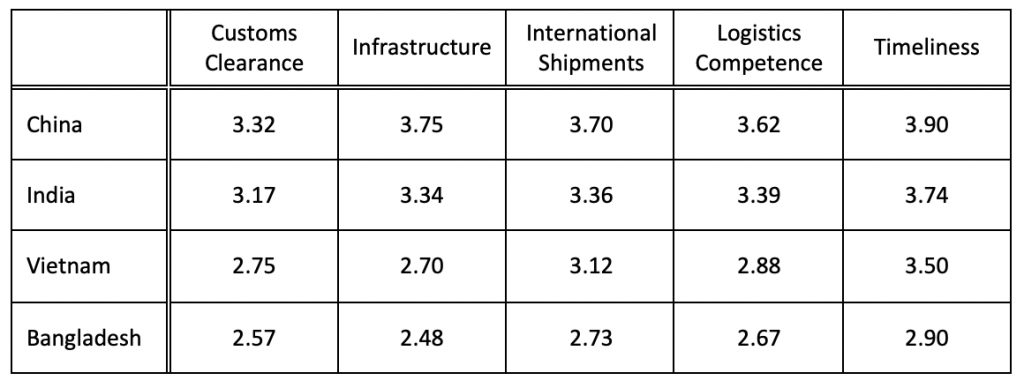
China’s well-developed supply chain makes it an ideal base for consumer electronics manufacturers like Foxconn, Neway, and DJI. Its excellent supply chain management facilities help clients ensure on-time cross-border movement of finished products consistently, allowing shorter lead times. Undertaking inland production in one’s home country poses huge logistical challenges as it is common for components to skate across different continents before arriving at their destination point. The varying international standards to go along with issues of compliance and traceability may raise operational problems. This scenario may be prevented if the client wholly outsources the manufacturing to electronics suppliers in China instead.
Potential Problems in China’s Consumer Electronics Industry
a. Time problems in the consumer electronics industry
The innovation of products in the consumer electronics industry comes at a rapid pace. In such a highly competitive industry, brands are fiercely eager to bring the newest technology to market first. To succeed, electronics brands must stay ahead of its competitors in terms of research and development, implementation and production output.
The first half of 2017 witnessed lead times increase in electronics production, as a result of production capacity concerns and sharp spikes in product demand. Unexpected problem areas in product development – like performance variations, negative reliability test results or faulty designs — escalate lead times, making lead time assessment and meticulous planning more imperative.
The procurement process also has to be set up in a timely manner and prices reassessed regularly. Flexibility in supplier selection is required to allow for immediate changes in supplier in case of backlogs or failure to deliver components at expected quality or rate. However, these steps are often overlooked by clients, resulting in higher costs and delays.
Without local presence in the region, clients are often left without any means to monitor compliance with project timeframes. Delays attributed to disrupted supply chains, design changes or extended failure analysis, are not always detected at once due to lack of transparency, preventing clients from seeking alternatives to keep the schedule on track. Clients are then left with no choice but de-feature the product or shell out more money to expedite. Further, offshore clients have no complete control over suppliers, devoid of means to enforce penalties for contractual breach.
b. Quality problems in the consumer electronics industry
Consumer electronics products come with a traditional promise of quality and reliability. The introduction of defective products to consumer markets diminishes branding – for instance, recall of Samsung’s Galaxy Note 7 negatively impacted Samsung’s smartphone market share – and results in lost consumer loyalty, costly product recalls, bad customer reviews or even lawsuits.
Quality issues are a normal part of electronics production, even in China’s highly automated manufacturing bases. There are underlying root causes, ranging from frequent design changes during testing, faulty coding implementation or negligent product testing. Poor workmanship is a common complaint against Chinese suppliers, who, as result of pressure to deliver on time or being granted project budgets at a bargain, rush client orders, only to come up with inferior electronics at a too high price.
As the products’ become increasingly complex, they are prone to non-apparent defects. Robust quality assessment of both micro/macro components is critical to ensure product functionality and compliance with technical specifications, otherwise, they won’t work at all. Low defect rates, reliability, and life expectancy differentiate high-quality electronics from low-quality variants.
Thus, strict quality standards and product testing must be carried out consistently, from design and manufacture through final release, to detect defects early on. Supplier assessment is likewise a must to determine if the supplier has proper certifications and licenses from China’s regulatory agencies.
c. Cost problems in the consumer electronics industry
A feasibility study significantly reduces the risks of setting up an offshore production line in China. When clients fail to conduct feasibility assessment before production, they base crucial business decisions on assumptions, not on relevant data. This leads to inaccurate cost estimates, overestimated production speed, higher costs, and schedule delays.
Since electronic components such as Printed Circuit Boards (PCB) is commonly made in China, there is a sprawling supply chain that caters to consumer electronics production. Strong competition exists among Chinese suppliers – entities with varying factory sizes, specializations, technical competencies, all vying for projects.
Clients, however, fail to take advantage of the density of suppliers, due to inability to make key assessment of suppliers’ production capacity and pricing. They fail to adequately survey the market for price comparison of assorted components. Too often, they miss out on suppliers offering better prices and end up sourcing costly, substandard product components from other suppliers.
d. Planning problems in the consumer electronics industry
Meticulous planning is critical to effective implementation of a production line in China. Before product development and OEM manufacturing, clients must clearly communicate to suppliers desired product specifications for their technological model – its software algorithms, hardware, appearance, and design.
This is where prototyping is most useful when it ensures the design is functional and feasible for mass production. Without utilizing prototypes, the project may suffer from frequent setbacks which result in longer lead times and high defect rates. A common problem, however, is the creation and coordination of prototypes can be costly. Suppliers prioritize clients depending on order requirements, so it is not easy for clients with small and medium orders to easily procure product prototypes.
e. General risks in the consumer electronics industry
Setting up offshore production lines in China for consumer electronics is an intricate process. It is highly technical and mandates rigorous supply chain management and strict quality assessment. To stay on track, due diligence and routine checkups with the suppliers are imperative.
Clients with no personal presence in China often find themselves distraught on how to go through the entire process, from finding the right supplier to producing the product prototype, without compromising quality. Without proper supplier selection, they run the risk of collaborating with suppliers who are ill-equipped to handle large-scale orders or implement product design changes.
By themselves, clients may encounter the pitfalls of bad contract negotiations, failing to execute a detailed Chinese contract that sets out the terms and condition of their agreement. This makes them vulnerable to contractual breach and incapable of legal enforcement mechanisms in case the supplier’s lack of transparency blindsides them with subpar product quality, under delivery and backlogs.
Setting up manufacturing of consumer electronics in China combining
good quality and prices is challenging.
Our Recommendations for China’s Consumer Electronics Industry
a. For reducing time required in the consumer electronics industry
Intrepid Sourcing has the experience and expertise to handle the process smoothly.We give clients an overview of China’s supplier listings, supply chains and product alternatives to help them make informed decisions along the way. Our up-to-date knowledge of market prices and price changes of different components enable you to reassess options quickly.
We work directly with different specialized suppliers that have the production capacity to fulfill order requirements (whatever the size) and implement product idea, branding and custom packaging strictly in accordance with desired specifications.
b. For ensuring quality in the consumer electronics industry
Consumer electronic products comprise hundreds of individual components and sub-assemblies, with defects not easily detectable. Intrepid Sourcing’s in person quality assessment and control helps identify product flaws during the early stages of product development to ensure all product units are working in excellent condition.
To avoid poor workmanship, we conduct rigorous supplier assessment and only entrust the project to reputable suppliers who have previous experience in supplying consumer electronics to popular global brands. We also double-check existing company and product certifications and help clients procure these certificates quickly at low costs.
c. For reducing costs in the consumer electronics industry
Intrepid Sourcing is able to identify legitimate suppliers with specialized knowledge on producing consumer electronics. With in-depth knowledge of current market prices and component specifications, we help clients select best quotations from potential suppliers based on metrics of quality, workmanship, and costs. Aware of prevailing fair prices of components in the markets, we can help you procure crucial electronics components at reduced costs.
d. For planning in the consumer electronics industry
Intrepid Sourcing streamlines the planning stage and dedicates focused effort towards clients. We make the process faster and more reliable for offshore clients, especially those who have no experience in outsourcing to Chinese suppliers.
We work with PCB prototyping and product development companies to expedite the lengthy process of product prototyping, helping our clients get the best rates for different electronic components and process alternatives. We can take over sample procurement within China, as we have access to skilled product engineers and designers, as well as reliable custom packing providers.
e. For minimizing risk in the consumer electronics industry
Intrepid Sourcing has its in-house electronics engineers that judge the design and requirements beforehand. Through this knowledge, we can assist you in procuring relevant certifications and effectively implementing production lines in collaboration with specialized consumer electronics suppliers. We also help execute a Chinese contract to protect your interest and safeguard your transactions with suppliers in China.

